
German postcard by Ross Verlag, no. 1319/1, 1927-1928. Photo: Loew Metro Goldwyn. John Gilbert in The Merry Widow (Erich von Stroheim, 1925).
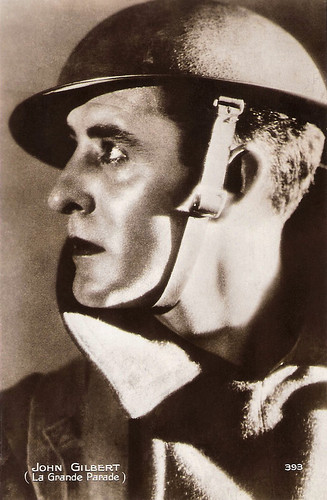
French postcard by Editions Cinémagazine, Paris, no. 393. Photo: MGM. Publicity still for The Big Parade (King Vidor, 1925).
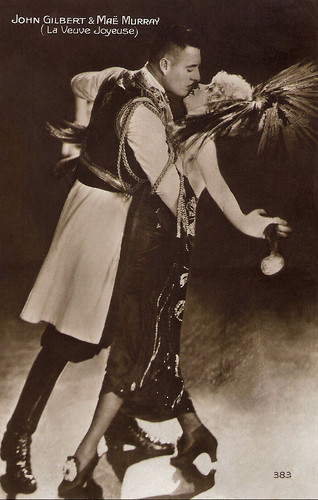
French postcard by Cinémagazine-Edition, Paris, no. 383. Photo: Metro-Goldwyn-Film. Publicity still for The Merry Widow (Erich von Stroheim, 1925) with Mae Murray.

German postcard by Ross Verlag, no. 63/1. Photo: Metro-Goldwyn-Mayer (MGM) / Parufamet. Publicity still for La Bohème (King Vidor, 1926) with Lillian Gish.

German postcard by Ross Verlag, no. 1886/1, 1927-1928. Photo: Clarence Sinclair Bull / Metro-Goldwyn-Mayer. Publicity still for Flesh and the Devil (Clarence Brown, 1926) with Greta Garbo.
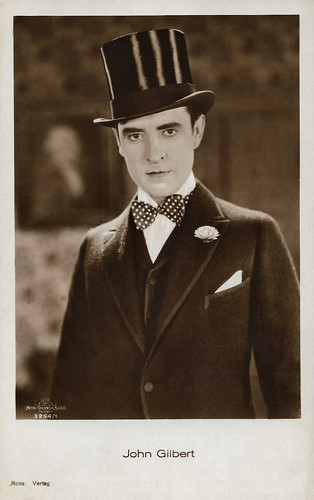
German postcard by Ross Verlag, no. 3254/1, 1928-1929. Photo: Metro-Goldwyn-Mayer.
Turning from villain to leading man
John Gilbert was born John Cecil Pringle in Logan, Utah, in 1899. His parents, John Pringle (1865–1929) and Ida Apperly Gilbert (1877–1913) were both stock-company actors. His father was a comic with the Pringle Stock Company. John struggled through a childhood of abuse and neglect. His family moved frequently and Gilbert attended several schools throughout the United States. After his family settled in California, he attended Hitchcock Military Academy in San Rafael, California. After he left school Gilbert worked as a rubber goods salesman in San Francisco, then as a stage manager in a stock company in Spokane, Washington in 1915. He lost his job when the company folded. He decided to try acting and got work in films as an extra. Gilbert first appeared in a short directed by Wilfred Lucas, The Mother Instinct (1915). He found work as an extra with the Thomas Ince Studios on films such as the historical war drama The Coward (Reginald Barker, 1915), the drama Aloha Oe (Richard Stanton, Charles Swickard, Gilbert P. Hamilton, 1915), and William S. Hart's Western Hell's Hinges (Charles Swickard, William S. Hart, Clifford Smith, 1916).
Gilbert began to get parts at Kay-Bee Pictures, billed as 'Jack Gilbert' in the Western The Aryan (William S. Hart, Reginald Barker, Clifford Smith, 1916) with William S. Hart, and the war film Shell 43 (Reginald Barker, 1916) with H.B. Warner. He had an early leading part in Kay-Bee's The Apostle of Vengeance (William S. Hart, Clifford Smith, 1916). His first leading role was in Princess of the Dark (Charles Miller, 1917) with Enid Bennett, but the film was not a big success and he went back to supporting roles in The Dark Road (Charles Miller, 1917), Happiness (Reginald Barker, 1917), and the drama The Hater of Men (Charles Miller, 1917). Gilbert did The White Heather (Maurice Tourneur, 1919) for Maurice Tourneur, Widow by Proxy (Walter Edwards, 1919) for Paramount, and Heart o' the Hills (Joseph De Grasse, Sidney Franklin, 1919) for Mary Pickford.
Tourneur signed him to a contract to both write and act in films. Gilbert acted in and co-wrote The White Circle (Maurice Tourneur, 1920), The Great Redeemer (Clarence Brown, Maurice Tourneur, 1921), and Deep Waters (Maurice Tourneur, 1921). As a writer, only he worked on The Bait (Maurice Tourneur, 1921), starring and produced by Hope Hampton. For Hampton, Gilbert wrote and directed, but did not appear in Love's Penalty (1921). In 1921 he signed a three-year contract with Fox Films. His popularity continued to soar and he was turning from villain to leading man. Fox gave Gilbert his first real starring part in Shame (Emmett J. Flynn, 1921). He followed it with leading roles in such films as Arabian Love (Jerome Storm, 1922) with Barbara LaMarr, Monte Cristo (Emmett J. Flynn, 1922) an adaptation of Alexandre Dumas' 'The Count of Monte Cristo', and A California Romance (1922). Many of these films were written by Jules Furthman.
He returned to Tourneur to co-star with Lon Chaney in While Paris Sleeps (Maurice Tourneur, 1923). Back at Fox, Gilbert starred in Truxton King (Jerome Storm, 1923), St. Elmo (Jerome Storm, 1923) with Barbara LaMarr and Bessie Love, and the drama Cameo Kirby (1923), directed by John Ford, co-starring Jean Arthur in her film debut. He appeared in The Wolf Man (Edmund Mortimer, 1923) with Norma Shearer. It was not a horror film, but the story of a man who believes he murdered his fiancee's brother while drunk. In 1924 he signed with MGM which put him into His Hour (King Vidor, 1924), written by Elinor Glyn and co-starring Aileen Pringle. It was a big success. He followed this with such high-profile films as He Who Gets Slapped (Victor Sjöström, 1924) co-starring Lon Chaney and Norma Shearer; and The Merry Widow (Erich von Stroheim, 1925), co-starring Mae Murray. The latter was a huge box-office success.
John Gilbert was once again directed by Vidor in the war epic The Big Parade (King Vidor, 1925), which became the second-highest-grossing silent film and the most profitable film of the silent era. His performance in this film made him a major star. Now at the height of his career, Gilbert rivalled Rudolph Valentino, another silent film-era leading man, as a box office draw. Lillian Gish, who had a new contract with MGM, picked Gilbert to co-star with her in La Bohème (King Vidor, 1926). He then did another film with Vidor, Bardelys the Magnificent (King Vidor, 1926).

American Arcade card. Photo: Fox. John Gilbert in Gleam O'Dawn (John Francis Dillon, 1922).
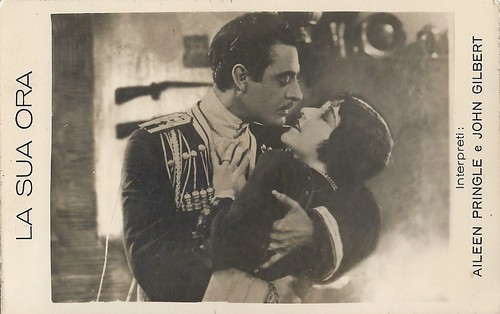
Italian postcard. Photo: MGM. John Gilbert and Aileen Pringle in the American silent drama His Hour (King Vidor, 1924).

Dutch postcard by M. Bonnist & Zonen, no. 115. Renée Adorée and John Gilbert in The Big Parade (King Vidor, 1925). Collection: Marlene Pilaete.

Italian postcard by G.B. Falci, Milano, no. 529. Photo: Metro-Goldwyn Films, Roma. Mae Murray and John Gilbert in The Merry Widow (Erich von Stroheim, 1925). The Italian title was La Vedova Allegra.
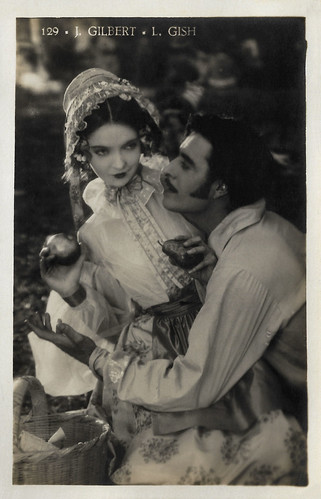
Italian postcard by Fotocelere, no. 129. Photo: Metro-Goldwyn-Mayer (MGM). Lillian Gish and John Gilbert in La Bohème (King Vidor, 1926).
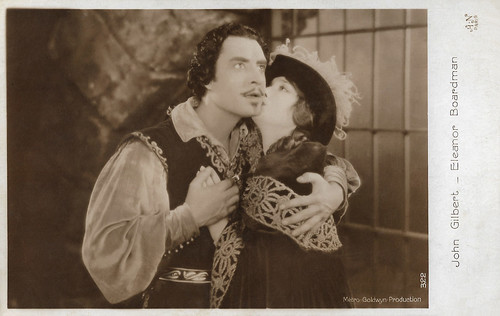
French postcard by A.N., Paris, no. 322. Photo: Metro-Goldwyn-Production. Publicity still for Bardelys the Magnificent (King Vidor, 1926) with Eleonor Boardman.
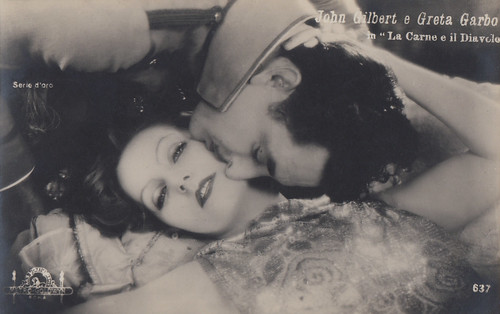
Italian postcard in the 'serie d'oro' by Ballerini & Fratini, Firenze, no. 637. Photo: Metro Goldwyn, Roma. Greta Garbo and John Gilbert in Flesh and the Devil (Clarence Brown, 1926). Collection: Marlene Pilaete.

German postcard by Ross Verlag, no. 3532/3, 1928-1929. Photo: Metro-Goldwyn-Mayer. John Gilbert and Greta Garbo in Love (Edmund Goulding, 1927), based on Lev Tolstoy's 'Anna Karenina'.

German postcard by Ross Verlag, no. 3778/1. Photo: Metro-Goldwyn-Mayer. Publicity still for The Cossacks (George Hill, Clarence Brown, 1928).

German postcard by Ross Verlag, no. 4509/1, 1929-1930. Photo: MGM. Eva von Berne and John Gilbert in The Masks of the Devil (Victor Sjöström, 1928).

German postcard by Ross Verlag, no. 5362/1, 1930-1931. Photo: Metro-Goldwyn-Mayer. Dorothy Sebastian and John Gilbert in A Woman of Affairs (Clarence Brown, 1928).
A torrid off-screen affair
Then came Greta Garbo. In 1926, John Gilbert made Flesh and the Devil (Clarence Brown, 1926), his first film with Garbo. They soon began a highly publicised, torrid off-screen affair, much to the delight of their fans. The screen chemistry between the two was incredible, and the studio publicity department worked overtime to publicise the romance between the two. The couple starred together again in Love (Edmund Goulding, 1927), and A Woman of Affairs (Clarence Brown, 1928). When it came time to marry, John was reportedly left at the altar. His performances after that were devoid of the sparkle that he once had and he began drinking heavily. Gilbert's popularity began to wane when silent pictures gave way to talkies. Gilbert was often cited as one of the high-profile examples of an actor who was unsuccessful in making the transition to talkies. His decline as a star had far more to do with studio politics and money than with the sound of his screen voice, which was rich and distinctive. Throughout his time at MGM, Gilbert frequently clashed with studio head Louis B. Mayer over creative, social, and financial matters.
Audiences awaited Gilbert's first romantic role on the talking screen. The vehicle was the Ruritanian romance His Glorious Night (1929), directed by Lionel Barrymore. According to reviewers, audiences laughed nervously at Gilbert's performance. The fault was not Gilbert's voice, it was said, but the awkward scenario along with overly ardent love scenes. In one, Gilbert keeps kissing his leading lady, (Catherine Dale Owen), while saying "I love you" over and over again. The scene was parodied in the MGM musical Singin' in the Rain (Stanley Donen, Gene Kelly, 1952) in which a preview of the fictional The Dueling Cavalier flops disastrously.
Garbo tried to restore some of his image when she insisted that he play opposite her in Queen Christina (Rouben Mamoulian, 1933), but by then it was too late. Columbia Pictures gave him what would be his final chance for a comeback in The Captain Hates the Sea (Lewis Milestone, 1934). The film involves a Grand Hotel-style series of intertwining stories involving the passengers on a cruise ship and Gilbert gave a capable performance as a frustrated playwright. But the off-screen cast of heavy drinkers encouraged his alcoholism and the film was his last. By 1934, alcoholism had severely damaged Gilbert's health. He suffered a serious heart attack in December 1935, which left him in poor health. Gilbert suffered a second heart attack at his Bel Air home on 9 January 1936, which was fatal.
Gilbert was married four times. His first marriage was to Olivia Burwell (1918-1921). In February 1921, Gilbert announced his engagement to actress Leatrice Joy. They married in Tijuana in November 1921. As Gilbert had failed to secure a divorce from his first wife and the legality of Gilbert and Joy's Mexican marriage was questionable, the couple separated and had the marriage annulled to avoid a scandal. They remarried in March 1922. The marriage was tumultuous and, in June 1923, Joy filed for legal separation after she claimed that Gilbert slapped her face after a night of heavy drinking. They reconciled several months later. In August 1924, Joy, who was pregnant with the couple's first child, filed for divorce. Joy later said she left Gilbert after discovering he was having an affair with actress Laurette Taylor. Joy also claimed that Gilbert had conducted affairs with Barbara La Marr, Lila Lee, and Bebe Daniels. Gilbert and Joy had a daughter, Leatrice Gilbert (1924-2015). Joy was granted a divorce in May 1925.
In 1929, Gilbert eloped with actress Ina Claire to Las Vegas. They separated in February 1931 and divorced six months later. Gilbert's fourth and final marriage was in August 1932, to actress Virginia Bruce, who had recently co-starred with him on the MGM film Downstairs (Monta Bell, 1932). Bruce retired briefly from acting following the birth of their daughter Susan Ann; however, she resumed her career after their divorce in May 1934.
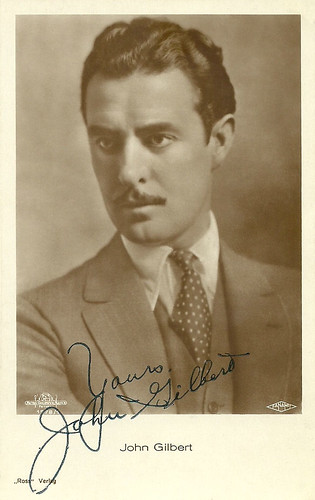
German postcard by Ross Verlag, no. 1578/1, 1927-1928. Photo: Metro Goldwyn Mayer / FaNaMet. Collection: Didier Hanson.
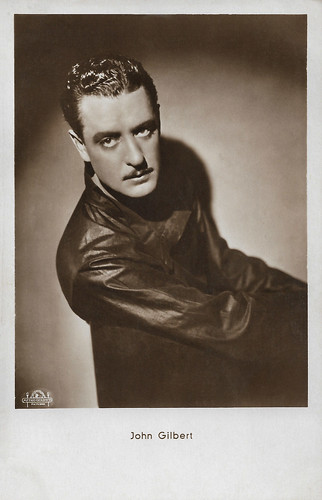
Austrian postcard by Iris Verlag, no. 6017. Photo: Metro-Goldwyn Pictures.

German postcard by Ross Verlag, no. 4510/2, 1929-1930. Photo: Metro-Goldwyn-Mayer. Publicity still for His Glorious Night (Lionel Barrymore, 1929).
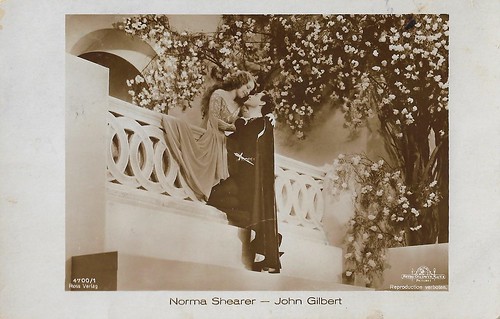
German postcard by Ross Verlag, no. 4700/1. Photo: Metro-Goldwyn-Mayer. Norma Shearer as Juliet and John Gilbert as Romeo in the early sound film The Hollywood Revue of 1929 (Charles Reisner, 1929), shot as a series of variety acts. In the film, this sequence was shot in two-color Technicolor.
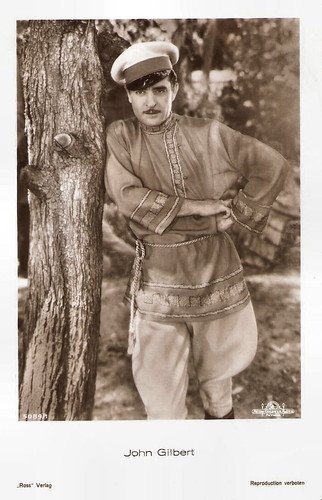
German postcard by Ross Verlag, no. 5089/1, 1930-1931. Photo: Metro-Goldwyn-Mayer. Publicity still for Redemption (Fred Niblo, 1930).

German postcard by Ross Verlag, no. 5361/1, 1930-1931. Photo: Metro-Goldwyn-Mayer. John Gilbert in the American pre-code sound film Way for a Sailor (Sam Wood, 1930).
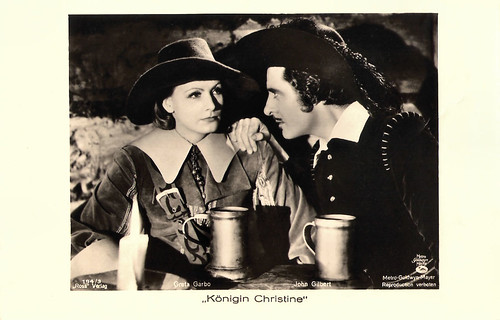
German postcard by Ross Verlag, no. 194/3. Photo: MGM. Publicity still for Queen Christina (Rouben Mamoulian, 1933) with Greta Garbo.

German postcard by Ross Verlag Foreign, no. 3938/1, 1928-1929. Photo: Metro-Goldwyn-Mayer.
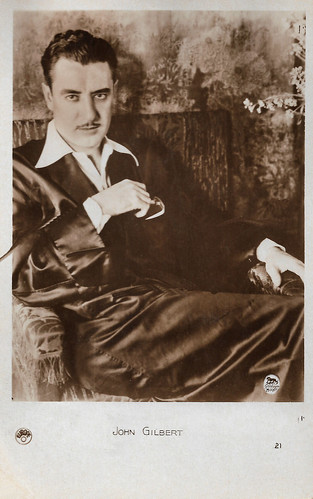
French postcard by Europe, no. 21. Photo: Metro-Goldwyn-Mayer.

German collectors card in the Moderne Schönheitsgalerie by Ross Verlag for Edelzigarette Kurmark, series 2, no. 47 (of 300). Photo: Metro-Goldwyn-Mayer. Greta Garbo and John Gilbert in Queen Christina (Rouben Mamoulian, 1933).
Sources: Tony Fontana (IMDb), Wikipedia, and IMDb.
This post was last updated on 20 May 2024.
No comments:
Post a Comment